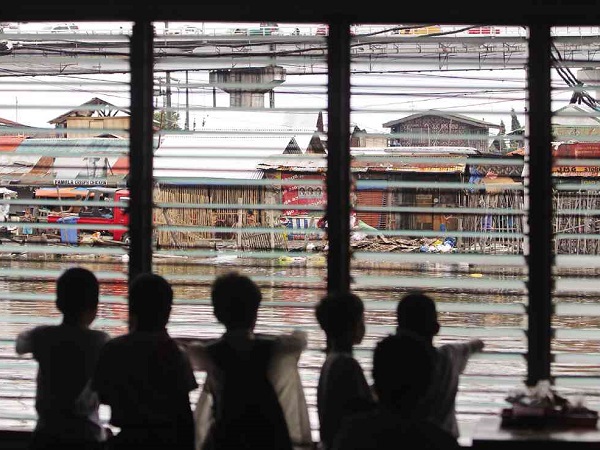
OOLCHILDREN of Cesar Cabahug Elementary School watch as floodwater goes up during high tide in Sitio Paradise, Barangay Looc, Mandaue City. TONEE DESPOJO/CDN
MANDAUE CITY, Cebu—The community is called “paradise,” but it hardly resembles one. During high tide, seawater seeps into Sitio Paradise, Barangay Looc, in Mandaue City, bringing along heaps of garbage, including feces. When the water recedes, usually after two hours, the streets are littered with trash.
Alice Lacrete, 56, a resident, says the intrusion could reach 2 feet deep. “It’s hard to walk because of the flood and garbage,” she says. Floods occur in June, July and August.
Seawater also inundates a portion of Cesar M. Cabahug Elementary School along the shoreline in the village. Although the pupils are safe in classrooms, what worries the principal, Zenaida Sucalit, is that the children have to wade into filthy floodwater to go to school and back home.
Eight-year-old Kurt Andrin, who is in Grade 2, says his father would carry him to school through the flooded streets. “There is too much garbage,” he says.
Tourists once flocked to Sitio Paradise before the 1970s because of its white-sand beach, says the barangay chair, Raul Cabahug. Filmmakers, he says, would even stay to shoot scenes.
“The place was really beautiful. There were mangroves and the beach was amazing. It was like a virgin paradise,” he says.
Conditions began to deteriorate in the 1970s when illegal settlers came in hordes and built their homes, many along the shoreline.
According to Cabahug, plans had been made to clear the coastline and solve the garbage problem by relocating the settlers to two five-story condominium buildings.
In early 2000, then Sen. Ernesto “Boy” Herrera gave P100 million from his priority development fund to Barangay Looc to build the condominium buildings near the University of Cebu campus. But the settlers would have to pay P4,000 to P5,000 in monthly amortization for 25 years.
The project fell through, Cabahug says, noting that the settlers had barely enough money to buy food.
The village officials decided to use the funds intended for the construction of the two buildings to provide livelihood to the beneficiaries for them to earn and, hopefully, be able to afford the housing units.
The scheme didn’t work out.
Cabahug says the barangay has not abandoned its plan to relocate the people even without the condominium units. Officials, however, would have to expect strong resistance.
“We won’t transfer. This is where I built my family and where my children grew up,” says Butchoy Manhatad, 42, one of those who moved in 15 years ago.
Roger Paller, city information officer, says the illegal structures must be removed near the shoreline so as to reclaim the foreshore area up to Cansaga Bay in the neighboring Consolacion town under Mandaue’s waterfront development plan.
The reclamation project would be a joint venture with a Manila-based firm, he says, adding that the city would not spend a single centavo but would get a share from the income with the developer under a mixed-use property deal.
To address the flooding problem, Paller says the city would elevate the land, especially near the perimeter fence where the seawater spills during high tide.
It is still a long way for the reclamation project to become a reality. Looc’s immediate concern is how to check the seawater intrusion and the trash problem.
Cabahug says the barangay is adopting measures, including a cleanup campaign, to make Sitio Paradise worthy of its name.